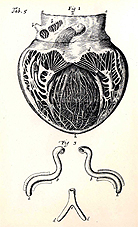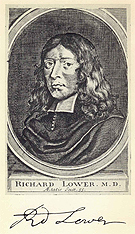Richard Lower and the "Life Force" of the Body
by Erin Moran

 This case study focuses on air's role in creating the bright red color of blood we are so familiar with today. Students follow the work of Richard Lower, one of the greatest physicians of the 17th century, as he works to explain why blood color in the veins differs from that in the arteries. Through discussion and hands-on activities, they adopt the role of the scientific community at Oxford and think through the same problems and questions faced by Lower himself. Ultimately, the students will discover that fresh air in the lungs, not heat or the motion of the heart, provide blood with the "life force" and red hue. Lessons about nature of science include:
This case study focuses on air's role in creating the bright red color of blood we are so familiar with today. Students follow the work of Richard Lower, one of the greatest physicians of the 17th century, as he works to explain why blood color in the veins differs from that in the arteries. Through discussion and hands-on activities, they adopt the role of the scientific community at Oxford and think through the same problems and questions faced by Lower himself. Ultimately, the students will discover that fresh air in the lungs, not heat or the motion of the heart, provide blood with the "life force" and red hue. Lessons about nature of science include:
- Science occurs in personal, cultural and historical contexts.
- Scientists may interpret the same evidence differently.
- Science is subject to conceptual change.
- Science is a collaborative process
This case study is valuable for addressing implicit intuitions about vitalism and for highlighting the role of experiment in characterizing living processes in concrete and observable terms.
Download PDF (includes module flowchart, 4 images and teaching notes).
|

